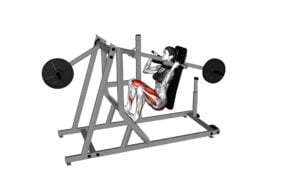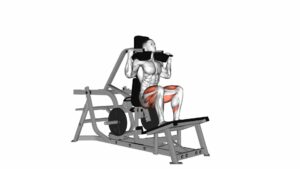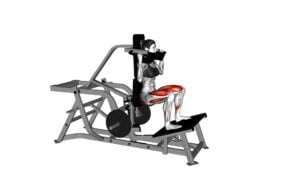Lever Pendulum Squat (Plate Loaded) – Video Exercise Guide & Tips

Are you looking to strengthen your lower body and improve your squat technique? Look no further than the lever pendulum squat!
Watch This Exercise Video
This video exercise guide and tips will walk you through the proper set-up, step-by-step instructions, and common mistakes to avoid.
Plus, we've included variations and modifications for all fitness levels.
Get ready to maximize your results with this challenging and effective exercise. Let's dive in and level up your squat game!
Key Takeaways
- Lever pendulum squat targets lower body muscles such as quadriceps, hamstrings, glutes, and core muscles.
- It engages multiple muscle groups simultaneously, enhancing functional strength and power.
- Proper weight plate placement and secure fastening are important for balance, stability, and injury prevention.
- Adjusting the lever arm height to a 90-degree knee bend is crucial for safe and effective exercise.
Benefits of Lever Pendulum Squat
You can experience a multitude of benefits from performing the Lever Pendulum Squat. This exercise is highly effective in targeting your lower body muscles while also improving stability and balance. One of the main advantages of this squat variation is its ability to engage multiple muscle groups simultaneously. By utilizing the proper technique, you can activate your quadriceps, hamstrings, glutes, and even your core muscles.
To perform the Lever Pendulum Squat correctly, start by positioning yourself on the machine with your feet shoulder-width apart and your back against the pad. Lower yourself down by bending your knees and hips, keeping your chest up and your back straight. As you descend, focus on driving your heels into the ground and pushing through your entire foot. This movement will activate your quadriceps and hamstrings, helping you build strength in these muscle groups.
Additionally, the Lever Pendulum Squat can also improve your overall functional strength and power. By engaging your lower body muscles, you'll develop the strength necessary for activities such as running, jumping, and even lifting heavy objects. Furthermore, this exercise can enhance your athletic performance by increasing your explosiveness and improving your ability to generate power from your legs.
Proper Set-up and Equipment
To ensure proper set-up and equipment for the lever pendulum squat, there are a few key points to keep in mind.
First, make sure to place the weight plates correctly on the lever arm to maintain balance and stability during the exercise.
Additionally, it's important to adjust the lever arm height according to your individual body mechanics and range of motion to optimize the movement and prevent any strain or discomfort.
Correct Weight Plate Placement
Ensure that weight plates are consistently and securely placed on the lever pendulum squat machine for optimal performance. Proper weight plate placement is essential to maintain balance and stability during your workout. Follow these guidelines to ensure you're positioning the weight plates correctly:
- Make sure the weight plates are evenly distributed on both sides of the machine.
- Align the plates parallel to the ground to maintain stability.
- Place heavier plates closer to the center of the machine to maintain proper weight distribution.
- Ensure that the plates are securely fastened using the provided clips or collars.
- Double-check the weight plate position before starting your lever pendulum squat technique to prevent any imbalance or potential injury.
By following these guidelines, you can enhance your lever pendulum squat workout and achieve better results while minimizing the risk of accidents or mishaps.
Adjusting Lever Arm Height
To properly set up the lever pendulum squat machine and equipment, begin by adjusting the height of the lever arm. This is a crucial step in ensuring that you can perform the exercise safely and effectively.
The lever arm position should be set at a height that allows your knees to bend to a 90-degree angle when you're in the lowest position of the squat. To adjust the lever arm, locate the lever arm adjustment mechanism on the machine. This can usually be found near the base of the machine or on the side.
Use the adjusting technique provided by the manufacturer to raise or lower the lever arm to the desired position. Once you have adjusted the lever arm to the correct height, you're ready to move on to the step-by-step guide to performing the exercise.
Step-by-Step Guide to Performing the Exercise
To perform the Lever Pendulum Squat (Plate Loaded) exercise correctly, it's important to focus on proper form demonstration. This will ensure that you engage the correct muscles and prevent injuries.
Additionally, understanding the common mistakes to avoid will help you get the most out of the exercise and maximize its benefits for your lower body strength and stability.
Proper Form Demonstration
How can you effectively perform the Lever Pendulum Squat (Plate Loaded) exercise with proper form?
Follow these proper form tips to ensure you perform the exercise correctly and maximize its benefits:
- Begin by positioning your feet shoulder-width apart and placing the barbell across your shoulders, resting on your traps.
- Keep your chest up and your back straight throughout the entire movement.
- Slowly lower your body into a squatting position by bending at the knees and hips, ensuring that your knees don't extend past your toes.
- Engage your glutes and hamstrings as you push through your heels to return to the starting position.
- Avoid rounding your back or leaning too far forward, as this can place unnecessary stress on your lower back.
Common Mistakes to Avoid
To perform the Lever Pendulum Squat (Plate Loaded) exercise correctly and avoid common mistakes, make sure to focus on maintaining proper form throughout the movement. This won't only help you maximize the benefits of the exercise, but also prevent injuries that can occur from incorrect technique.
One common misconception is that you should let your knees cave inwards as you descend into the squat. However, this can put unnecessary stress on your knee joints. Instead, make sure to keep your knees in line with your toes throughout the movement.
Another mistake to avoid is rounding your back or hunching your shoulders. This can strain your lower back and lead to discomfort or injury. Keep your chest up and maintain a neutral spine to protect your back.
By avoiding these common mistakes, you can perform the Lever Pendulum Squat (Plate Loaded) exercise safely and effectively.
Now, let's move on to the benefits of this exercise.
Benefits of Exercise
To perform the Lever Pendulum Squat (Plate Loaded) exercise correctly and avoid common mistakes, you can benefit from following a step-by-step guide. This exercise provides numerous benefits, including the importance of consistency and mental health benefits. Here are some key points to consider:
- Consistency is crucial for achieving optimal results. Regularly performing the Lever Pendulum Squat will help build strength, improve mobility, and enhance overall fitness.
- The exercise engages multiple muscle groups, including the quadriceps, hamstrings, glutes, and core, leading to improved muscle tone and increased functional strength.
- By incorporating the Lever Pendulum Squat into your routine, you can also enhance your balance and stability, reducing the risk of falls and injuries.
- Physical activity, such as this exercise, has been shown to positively impact mental health by reducing stress, improving mood, and boosting self-esteem.
- Including the Lever Pendulum Squat in your workout regimen can help you achieve a well-rounded fitness routine and maximize the benefits of your exercise program.
Now that you understand the benefits of the Lever Pendulum Squat, let's explore some common mistakes to avoid.
Common Mistakes to Avoid
Avoiding common mistakes is essential when performing the Lever Pendulum Squat (Plate Loaded) exercise. By understanding and correcting these common form errors, you can maximize the effectiveness of the exercise and reduce the risk of injury.
One common mistake is rounding your back during the squat. This places unnecessary stress on the spine and can lead to back pain or injury. To avoid this, focus on maintaining a neutral spine throughout the movement.
Another mistake to avoid is allowing your knees to cave inward. This puts excessive strain on the knee joint and increases the risk of injury. Instead, actively push your knees outwards, in line with your toes, throughout the entire squat.
Lastly, avoid lifting your heels off the ground. This shifts the weight forward and can cause instability or strain on the ankles. Keep your heels firmly planted throughout the exercise to maintain balance and stability.
Tips for Maximizing Results
To maximize your results, focus on proper form and technique when performing the Lever Pendulum Squat (Plate Loaded) exercise. Here are some tips for progression and alternative exercises to help you get the most out of your workout:
- Start with light weights and gradually increase the load as you become more comfortable with the movement. This will help you avoid injury and allow your muscles to adapt to the exercise.
- Make sure to maintain a neutral spine throughout the exercise. Keep your chest up, shoulders back, and core engaged to prevent any unnecessary strain on your lower back.
- Control the descent and ascent of the squat. Avoid bouncing or using momentum to lift the weight. This will ensure that you're effectively targeting your leg muscles and maximizing the benefits of the exercise.
- If you're looking for a more challenging variation, you can try single-leg lever pendulum squats. This will help improve your balance and stability while targeting each leg individually.
- If you don't have access to a lever pendulum squat machine, you can still work your legs effectively with alternative exercises such as barbell squats, dumbbell lunges, or Bulgarian split squats. These exercises will target similar muscle groups and provide a great workout.
Variations and Modifications for All Fitness Levels
For all fitness levels, there are various variations and modifications of the Lever Pendulum Squat (Plate Loaded) exercise. These variations allow you to tailor the exercise to your specific needs and abilities, ensuring that you can still benefit from the exercise regardless of your fitness level.
One variation you can try is the assisted Lever Pendulum Squat. This modification involves using a resistance band or a pulley system to provide some assistance during the movement. This can be helpful for beginners or individuals with limited strength, as it reduces the amount of weight they've to lift and allows them to focus on their form and technique.
On the other hand, if you're looking to challenge yourself and take the exercise to the next level, you can try the single-leg Lever Pendulum Squat. This variation requires you to perform the exercise while standing on one leg, which not only increases the demand on your muscles but also improves your balance and stability.
Regardless of the variation or modification you choose, it's important to remember to maintain proper form and technique throughout the exercise. This includes keeping your back straight, knees aligned with your toes, and engaging your core muscles. Start with lighter weights or assistance if needed and gradually increase the difficulty as you become more comfortable and stronger.
Frequently Asked Questions
What Is the Recommended Weight Range for Beginners When Performing the Lever Pendulum Squat?
When starting out with the lever pendulum squat, it's important to choose a weight range that's suitable for beginners. The recommended weight range for beginners can vary depending on your strength and fitness level.
It's always a good idea to start with lighter weights and gradually increase as you get more comfortable with the exercise. If you don't have access to plate loaded equipment, you can try equipment-free variations of the squat to build strength before progressing to the lever pendulum squat.
Can the Lever Pendulum Squat Be Performed Without Any Equipment?
To perform the lever pendulum squat without any equipment, there are alternative exercises you can try.
However, the lever pendulum squat specifically utilizes plate loaded equipment, which offers unique benefits. Plate loaded equipment allows for progressive overload and customization of weight, targeting specific muscle groups effectively. It also provides stability and safety during the exercise.
While alternatives exist, the lever pendulum squat with plate loaded equipment is a highly effective and recommended option for optimal results.
How Often Should One Incorporate the Lever Pendulum Squat Into Their Workout Routine?
To effectively incorporate the lever pendulum squat into your workout routine, it's important to consider your fitness level and training goals.
For advanced athletes, incorporating variations of the lever pendulum squat can provide a challenging and effective lower body workout.
Additionally, if you're looking to add plyometric exercises to your routine, the lever pendulum squat can be a great choice.
However, it's essential to consult with a qualified trainer or coach to ensure proper form and technique to avoid injury.
Are There Any Specific Muscle Groups That the Lever Pendulum Squat Primarily Targets?
The lever pendulum squat primarily targets specific muscle groups in your lower body. This exercise works your quadriceps, hamstrings, glutes, and calves. It helps to strengthen and tone these muscles, improving your overall lower body strength and stability.
There are also variations and modifications you can try to target different muscle groups or add more challenge to the exercise.
Incorporating the lever pendulum squat into your workout routine can be a great way to target and strengthen your lower body.
Can the Lever Pendulum Squat Be Beneficial for Individuals With Knee or Hip Injuries?
Yes, the lever pendulum squat can be beneficial for individuals with knee or hip injuries. To modify this exercise, you can decrease the range of motion or use lighter weight. This will help reduce the stress on your knees and hips while still allowing you to work your leg muscles.
The lever pendulum squat can also help rehabilitate knee or hip injuries by strengthening the surrounding muscles and improving stability.
Always consult with a healthcare professional before starting any new exercise routine.
Conclusion
In conclusion, the lever pendulum squat is a highly effective exercise for targeting and strengthening the lower body muscles.
With proper set-up and equipment, along with the correct technique, this exercise can help improve balance, stability, and overall lower body strength.
By avoiding common mistakes and following the tips provided, individuals can maximize their results and achieve their fitness goals.
With variations and modifications available, this exercise is suitable for all fitness levels.

Author
Years ago, the spark of my life’s passion ignited in my mind the moment I stepped into the local gym for the first time. The inaugural bead of perspiration, the initial endeavor, the very first surge of endorphins, and a sense of pride that washed over me post-workout marked the beginning of my deep-seated interest in strength sports, fitness, and sports nutrition. This very curiosity blossomed rapidly into a profound fascination, propelling me to earn a Master’s degree in Physical Education from the Academy of Physical Education in Krakow, followed by a Sports Manager diploma from the Jagiellonian University. My journey of growth led me to gain more specialized qualifications, such as being a certified personal trainer with a focus on sports dietetics, a lifeguard, and an instructor for wellness and corrective gymnastics. Theoretical knowledge paired seamlessly with practical experience, reinforcing my belief that the transformation of individuals under my guidance was also a reflection of my personal growth. This belief holds true even today. Each day, I strive to push the boundaries and explore new realms. These realms gently elevate me to greater heights. The unique combination of passion for my field and the continuous quest for growth fuels my drive to break new ground.







